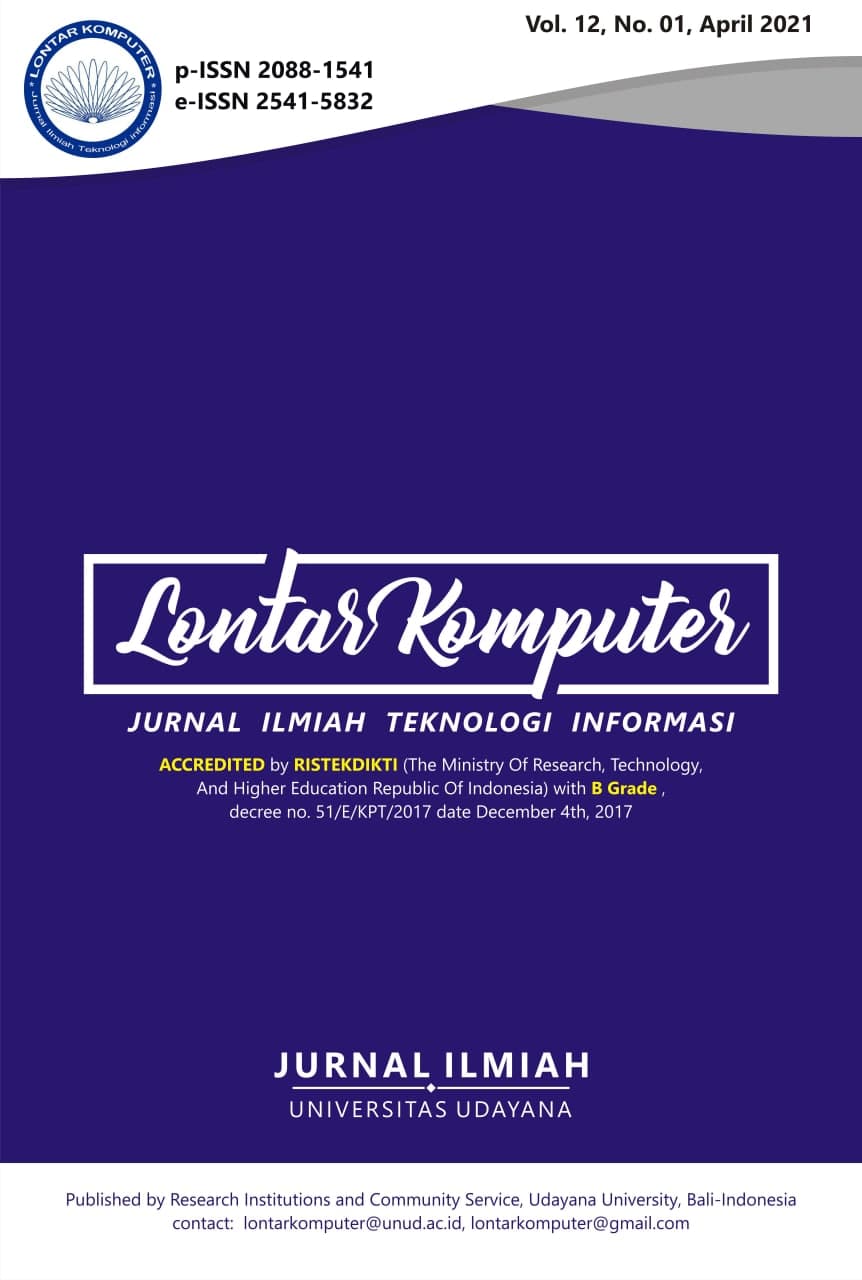Electrooculogram (EOG) based Mouse Cursor Controller Using the Continuous Wavelet Transform and Statistic Features
Abstract
This study design a system prototype to control a mouse cursor's movement on a computer using an electrooculogram (EOG) signal. The EOG signal generated from eye movement was processed utilizing a microcontroller with an analog to the digital conversion process, which communicates with the computer through a USB port. The signal was decomposed using continuous wavelet transform (CWT), followed by feature extraction processes using statistic calculation, and then classified using K-Nearest Neighbors (k-NN) to decide the movement and direction of the mouse cursor. The test was carried out with 110 EOG signals then separated, 0.5 as training data and 0.5 as test data with eight categories of directional movement patterns, including up, bottom, right, left, top right, top left, bottom right bottom left. The highest accuracy that can be achieved using CWT-bump and kurtosis is 100%, while the time needed to translate the eye movement to the cursor movement is 1.9792 seconds. It is hoped that the proposed system can help assistive devices, particularly for Amyotrophic Lateral Sclerosis (ALS) sufferers.
Downloads
References
[2] X. Zhang, X. Liu, S. M. Yuan, and S. F. Lin, "Eye Tracking Based Control System for Natural Human-Computer Interaction," Computational Intelligence and Neuroscience, vol. 2017, pp. 1–9, 2017, doi: 10.1155/2017/5739301.
[3] D. Y. Kim, C. H. Han, and C. H. Im, "Development of an electrooculogram-based human-computer interface using involuntary eye movement by spatially rotating sound for communication of locked-in patients," Scientific Reports, vol. 8, no. 1, pp. 1–10, 2018, doi: 10.1038/s41598-018-27865-5.
[4] C.-Y. Su and J.-J. Wong, "Connecting with Dysphonia: Human-Computer Interface for Amyotrophic Lateral Sclerosis Patients," 2011, pp. 453–457.
[5] H. Ka Hou and S. K.G., "Low-Cost Wireless Electrooculography Speller," in 2018 IEEE International Conference on Systems, Man, and Cybernetics (SMC), Oct. 2018, pp. 123–128, doi: 10.1109/SMC.2018.00032.
[6] G. Teng, Y. He, H. Zhao, D. Liu, J. Xiao, and S. Ramkumar, "Design And Development Of Human Computer Interface Using Electrooculogram With Deep Learning," Artificial Intelligence in Medicine, vol. 102, p. 101765, Jan. 2020, doi: 10.1016/j.artmed.2019.101765.
[7] O. Hardiman et al., "Amyotrophic lateral sclerosis," Nature Reviews Disease Primers, vol. 3, no. 1, p. 17071, Dec. 2017, doi: 10.1038/nrdp.2017.71.
[8] E. Zucchi et al., "Neurofilaments in motor neuron disorders: towards promising diagnostic and prognostic biomarkers," Molecular Neurodegeneration, vol. 15, no. 1, p. 58, Dec. 2020, doi: 10.1186/s13024-020-00406-3.
[9] D. Yuan et al., "A closed-loop electrical stimulation system triggered by EOG for acupuncture therapy," Systems Science & Control Engineering, vol. 8, no. 1, pp. 128–140, 2020, doi: 10.1080/21642583.2020.1733130.
[10] A. Bissoli, D. Lavino-Junior, M. Sime, L. Encarnação, and T. Bastos-Filho, "A human–machine interface based on eye tracking for controlling and monitoring a smart home using the internet of things," Sensors (Switzerland), vol. 19, no. 4, pp. 1–26, 2019, doi: 10.3390/s19040859.
[11] C.-I. Wu, "HCI and Eye Tracking Technology for Learning Effect," Procedia - Social and Behavioral Sciences, vol. 64, pp. 626–632, Nov. 2012, doi: 10.1016/j.sbspro.2012.11.073.
[12] A. Sahayadhas, K. Sundaraj, and M. Murugappan, "Detecting Driver Drowsiness Based on Sensors: A Review," Sensors, vol. 12, no. 12, pp. 16937–16953, Dec. 2012, doi: 10.3390/s121216937.
[13] J. Xu, J. Min, and J. Hu, "Real-time eye tracking for the assessment of driver fatigue," Healthcare Technology Letters, vol. 5, no. 2, pp. 54–58, 2018, doi: 10.1049/htl.2017.0020.
[14] W. S. Sanjaya, D. Anggraeni, R. Multajam, M. N. Subkhi, and I. Muttaqien, "Design and Experiment of Electrooculogram (EOG) System and Its Application to Control Mobile Robot," Journal of Physics: Conference Series, vol. 180, pp. 1–8, 2017, doi: 10.1088/1742-6596/755/1/011001.
[15] R. B. Navarro, L. B. Vázquez, and E. L. Guillén, EOG-based wheelchair control, Second Edition Elsevier B.V., 2018.
[16] N. Borkar, T. Dongare, P. Chahande, J. Bonsod, and A. B. Jirapure, "Microcontroller Based EOG and Accelerometer Guide Wheelchair," International Research Journal of Engineering and Technology (IRJET), vol. 5, no. 3, pp. 3803–3807, 2018.
The Authors submitting a manuscript do so on the understanding that if accepted for publication, the copyright of the article shall be assigned to Jurnal Lontar Komputer as the publisher of the journal. Copyright encompasses exclusive rights to reproduce and deliver the article in all forms and media, as well as translations. The reproduction of any part of this journal (printed or online) will be allowed only with written permission from Jurnal Lontar Komputer. The Editorial Board of Jurnal Lontar Komputer makes every effort to ensure that no wrong or misleading data, opinions, or statements be published in the journal.
 This work is licensed under a Creative Commons Attribution 4.0 International License.
This work is licensed under a Creative Commons Attribution 4.0 International License.























